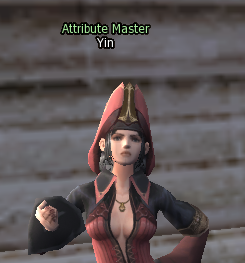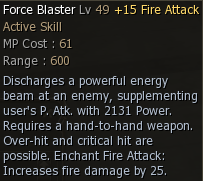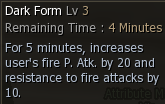PART: 1
Attribute Types and Opposite Elements.
The attribute system is designed to provide an additional way to affect the damage output of each character in both PvP and PvE, through the use of regular and skill attacks. There are 6 attributes in total Ė 4 to represent the elements of nature and 2 which are called alignment attributes.
Attributes are coupled together in mutual exclusive opposites, as follows:
Fire <<-
 Water
WaterEarth <<-
 Wind
WindDark <<-
 Holy
HolyAttributes can affect both the attack and the defense of a character. The attribute damage dealt by an attacking character to a defending character is equal to the difference between the attackerís attack attribute and the defenerís attribute resistance (which is the total value of defense attributes).More about this later.
Applying Attributes. Attribute Items.
part from skills with a built-in attribute, buffs providing an increase in attack or defense attributes, and attributes received through skill enchant, you can also add attributes to your weapons and armor set pieces (excluding shields, shirts, belts, cloaks, accessories, headgears and so on). Only S-Grade and higher grade items can have attribute effects applied to them.
To do that, you need to use attribute items. There are currently two types of those items Ė attribute stones and attribute crystals. When you apply attribute items successfully, you increase either the attack or defense attribute value of an item. Attributes applied to weapons add to your attack attribute value and those applied to armor pieces count towards your attribute resistance values in your stats window.
Stones & Crystals

 Fire
Fire
 Water
Water
 Earth
Earth
 Wind
Wind
 Dark
Dark
 Holy
HolyTo apply an attribute item simply double click it while itís in your inventory. You can also drag it onto your toolbar and use it just like other items, such as healing potions.
Attribute values and levels
The maximum attribute value for a weapon is currently 300 and the maximum value of a single attribute on armor pieces is 120.
Attribute values are also categorized in levels, depending on the current attribute value on a weapon or armor piece. Attribute stones can increase the attribute values of weapons and armors up to level 3. Attribute crystals can increase the attribute above level 3 and up to level 6.
The increase amount for each successful use of attribute stones/crystals is 6 attribute points for weapons and 5 for armor pieces. The only exception to this is the initial attribute application to weapons that have no attribute. In that case, the first successful use of attribute stones on a weapon increases its attribute by 20.
The total amount of attack attribute and attribute resistance given by weapons, armor pieces, accessories (i.e. RB jewelry), potions and skills can be seen in the Character Status Window (accessed by Alt+T).

Important note: Applying attribute items to armor pieces increases resistance to the opposite element. E.g. if you use a Fire attribute stone on your Draconic Gloves, it will increase the amount of Water defense they provide while youíre wearing them.
Attribute Enchant Chance. (Each server may have their own enchant chance rates.)
The chance to successfully use an attribute item (stone or crystal) is not 100%. From my research and testing it seems to vary between 40% and 60%. One tip I can give is this: get a good amount of stones/crystals before enchanting your weapons/armors.
I donít know if itís some probability theory or just the way chance works, but if you try to use just a few stones/crystals at a time (say, 2-3), you are relying on sheer luck a lot more. If you use a decent number of stones/crystals (e.g. 15-20), in a row without pausing, the overall success rate rounds up at around 50-60% nearly all the time. Itís the same for any kind of chance-based action really.
Anyway, failing to enchant your items would not result in loss of attribute level or the destruction of your item.
Attribute Master NPC Ė Attribute Potions and Attribute Stones/Crystals Exchange.

The Attribute Master NPC provides a couple of services in relation to the attribute system. There are currently two Attribute Master NPCs Ė in Aden outside the Blacksmith Shop and in Rune Castle Town just north of the Gatekeeper.
You can buy attribute potions for any of the 6 attribute elements from those NPCs. These potions give you a 10 minutes buff which increases the attribute resistance for the element of your choice by 30.
You can also exchange attribute stones for the same number of attribute stones of the opposite type for free, i.e. water stones for fire stones. Crystals cannot be exchanged this way though.
On High Five, you now also have the option to exchange attribute stones for attribute crystals. The rate of exchange is 5 single-type attribute stones plus 3 million Adena for 1 Crystal of the same attribute.
Lastly, the NPC gives you the option to remove an attribute from your weapon or armor piece for a small fee. This way you can apply new attribute to your items if you want to.
Getting Attribute stones&crystals.
In Exillium server you can get attribute stones&crystals by hunting/farming in Seed of Annihilation.

Or buy at gmshop npc in any town for silver coins and adenas.
Items, Buffs and Skills Attribute Calculation Priority. Servitor Attack Attribute Inheritance.
While attribute resistance is calculated in a pretty much straightforward way by simply accumulating all defense attribute values coming from items and skills, the attack attribute calculation is more involved and has some rules and restrictions.
Before we see how the final attack attribute is applied, letís look at the different sources of attack attribute values.
Attributes of Attack Skills and Attribute Skill Enchant.
Some attack skills of different classes have a built-in attribute which defines the type of damage dealt to a target.
Example: Tyrantís Burning Fist has a Fire attribute and therefore it deals Fire damage to a target.
Other skills have no attribute and so they deal non-attribute damage. This can be modified via Skill Enchantment which gives the option to enchant many of the skills for different attribute elements.
Example: Tyrantís Force Blaster is a non-attribute skill by default, but if enchanted for Fire, it would obtain a Fire attribute and thus deal Fire damage.
The amount of total attack attribute value which each skill contributes is equal to a combination of its default attribute (or lack of) and the level of attribute skill enchantment.
Example: Burning Fist with its default Fire attribute adds 20 Fire attack attribute points by default, while Force Blaster with its non-attribute property doesnít add any attack attribute points.
Skill enchanting can increase the attribute of an attack skill by up to 50 points (at +30 skill enchant level). Roughly, you get an increase of 1-2 attribute points per enchant level.
Example: Letís say you enchant Burning Fist for Fire and you reach skill enchant level of +15. This is an increase of about 25 Fire attribute points and itís added to Burning FistĎs default which is 20 Fire attribute points. The overall Fire attack attribute of Burning Fist becomes 45.

With Force Blaster as an example and a Fire skill enchant level of +15, you add 25 Fire attribute points to the skillís default which is 0 in this case, so you get a final Fire attack attribute of 25.
In the case where you enchant a naturally attributed skill to a different attribute than its own, the skill enchant attribute route overwrites the natural attribute.
Example: You enchant Burning Fist (which provides a default of +20 Fire attack attribute) up to +15 on the Wind Attack skill enchant route. The overall attack attribute bonus of the skill becomes +25 Wind and the natural Fire attribute is ignored completely.


Comment